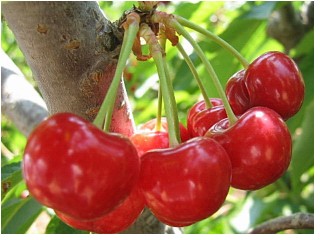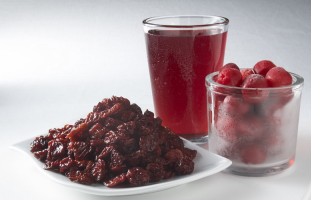|
Tart Cherries
Tart cherries technically known as Prunus Cerasus, and often called "sour cherries", have been recently identified as having Melatonin in them. It has been known that some foods contain very small amounts of melatonin: bananas, rolled oats and corn for example. But tart (sour) cherries, especially the Montmorency variety, have been scientifically proven to have the largest concentration - such a significant amount that it is actually enough to produce positive results in the body. Dr. Russel Reiter of the University of Texas Health Science Center who is a distinguished researcher of melatonin, stated: "We were surprised at how much melatonin was in cherries, specifically the Montmorency variety." Montmorency cherries which account for the majority of cherries grown in the US contain approximately 13.5 nanograms (ng) of melatonin per 1 gram of cherries which is higher than the amount normally found in the blood. Dr. Reiter and the researchers from Japan also proved that melatonin ingested from the diet is absorbed and enters the blood circulation, after which it is capable of binding to sites in the brain and other tissues. Other compounds found in cherries are gallic acid, p-coumaric acid, kaempferol, quercetin, ellagic acid - all of which are potent antioxidants. Test tube studies have shown that perillyl alcohol, also present in tart cherries, may help prevent the formation and progression of certain cancers, revert tumor cells back to normal, and help reduce the blood supply to cancer cells thus starving them of oxygen and nutrition. Tart (sour) cherries and the compounds found in them have been associated with a lower risk for a number of health conditions: arthritis, gout, heart disease, diabetes, cancers, brain health, muscle soreness during and after exercise, and weight management to mention a few. ORAC Score of tart cherries Antioxidant capacity of foods is measured in ORAC (Oxygen Radical Absorbance Capacity) units. ORAC score shows how many oxygen radicals a food can absorb and deactivate. The ORAC value is expressed in micromoles of Trolox Equivalents (µmol/TE) per 100 grams of sample (this is the laboratory measure of ORAC). The higher the score the better a food may be in its ability to fight oxidants. Nutrition experts estimate that a person needs to consume 3,000 - 5,000 ORAC units a day. Below you will find a table comparing ORAC scores of various fruits and vegetables. Just 3.5 ounces (100 grams) of concentrated cherry juice provide 12,800 ORAC units; or just one serving of 1 ounce (2 tablespoons) will supply 3,657 ORAC units, which is more than the minimum daily recommended amount. Dried cherries can be added to cereals, oatmeal, salads, nut mixes, or simply enjoyed as a snack. Frozen cherries after thawing and canned cherries can be used in cereals, yogurt, oatmeal, smoothies, and well drained in baking. Our favorite is cherry juice concentrate: 1 ounce serving (2 table spoons) contains all the goodness from about 100 (!) cherries. It can be used as is, or reconstituted in 6-8 ounces of water and taken as an excellent source of antioxidants, to help ease pain, or right before bedtime as a natural sleep aid. Tart cherry concentrates vary slightly from manufacturer to manufacturer. As we mentioned above, the highest melatonin concentrations are found in tart cherry juice concentrate made from Montmorency variety cherries. Quite often though cherry concentrates are made from Balaton cherries - the taste is sweeter, less tart and melatonin concentrations are lower. So, when shopping around for quality tart cherry juice concentrate, make sure you pick Montmorency concentrate. According to the information on the web-site of Michigan cherry growers King Orchards 1 ounce of concentrated cherry juice from Montmorency cherries contains approximately 4910 ng (4.91 mcg) of natural melatonin, which is about the minimum amount circulating in the blood stream of a healthy male adult at night time.
To check out what nutrients are in such exotic berries as acai, goji, noni, mangosteen and camu camu visit our page
Antioxidant Juice Comparison. |
press 'Ctrl' and '+'
To decrease font size:
press 'Ctrl' and '-'
|
|

Antioxidants and Immune Health
Anthocyanins
Proanthocyanidins
Tannins
Resveratrol
Quercetin
Carotenes
Lutein and Zeaxanthin
Astaxanthin
Lycopene
Melatonin


 But if you would like to add cherries to your diet, you have several other choices: these delicious berries are usually available as dried cherries, frozen cherries, canned cherries and cherry juice concentrate. These products can also be found at some whole food, organic food stores or some health food stores.
But if you would like to add cherries to your diet, you have several other choices: these delicious berries are usually available as dried cherries, frozen cherries, canned cherries and cherry juice concentrate. These products can also be found at some whole food, organic food stores or some health food stores. 